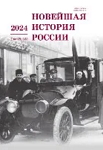Социально-демографический портрет работников НКВД областного уровня в 1930-е годы
Social and demographic portrait of NKVD workers at the regional level in the 1930s
Author(s): D. A. SafonovSubject(s): Labor relations, Government/Political systems, Security and defense, Demography and human biology, Interwar Period (1920 - 1939)
Published by: Издательство Исторического факультета СПбГУ
Keywords: state security; Stalin; personnel; terror; purge; personal files; socio-demographic characteristics;
Summary/Abstract: The study is devoted to analysis of the socio-demographic characteristics of the revolutionary generation that took an active part in the construction of a new world. Most domestic researchers dealing with similar issues focus their attention on the repressive actions of the OGPU — NKVD, their participation in the “Great Terror”, and personally on the leadership team. The rank-and-file composition of the organs at the regional level, a “generational” section precisely, for obvious reasons, remained poorly studied. The author assumes that the study of this group will provide an opportunity to understand the inner world of the revolutionary generation better, which is the purpose of the study. The main source for writing the article was the personal files of the NKVD party nomenklatura (state security workers only) from 1935 to 1939 in the Orenburg region. Data from the autobiographies, as well as the questionnaires, formed the basis for creating a database table and made it possible to analyze their main sociographic characteristics. There were serious changes in the age and qualification requirements for employees of state security agencies in the period 1937–1939. The fairly widespread opinion about the extermination of “old” personnel during this period naturally explained the inevitable increase in the number of young workers. Facts indicate that the purge of NKVD personnel during the period under review did not mean mandatory repressive measures against those dismissed from the authorities (if dismissal is not considered as repression). The similarity in the level of education and training of personnel who joined the authorities in the second half of the 1930s, as well as their subsequent career growth, suggests that the existing level was considered quite sufficient for the performance of official duties.
Journal: Новейшая история России
- Issue Year: 14/2024
- Issue No: 3
- Page Range: 670-685
- Page Count: 16
- Language: Russian

